#parabolic architecture
Explore tagged Tumblr posts
Text













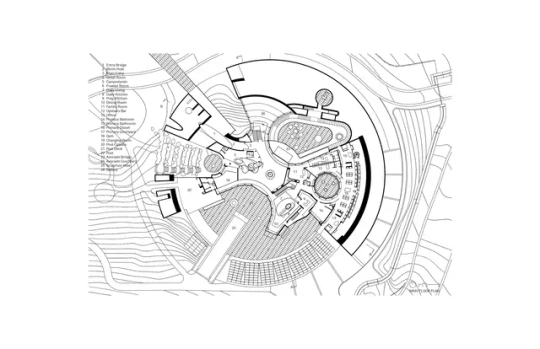
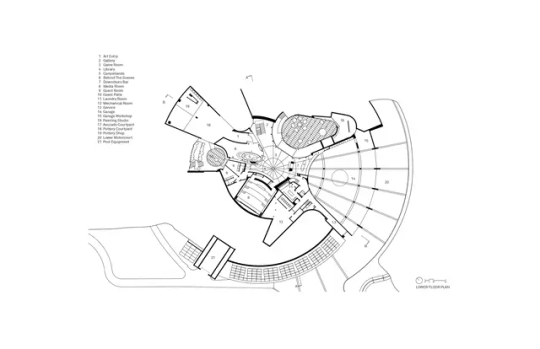

"Hill House," Montecito, California,
Donaldson + Parners
#art#design#architecture#luxury pad#luxury lifestyle#ultimate pad#interior design#luxurypad#luxury house#luxury home#giga mansion#montecito#california#donaldson+partners#bruce heavin#lynda weinman#parabolic architecture
123 notes
·
View notes
Text



"Hill House," Montecito, California,
Donaldson + Parners
#art#design#architecture#doorway#heavensdoorways#doors#doorsdesign#doordesign#entrance door#glass door#luxury house#luxury home#montecito#california#sculpture#donaldson+partners#hillhouse#metalwork#organic#parabolic architecture
7 notes
·
View notes
Text
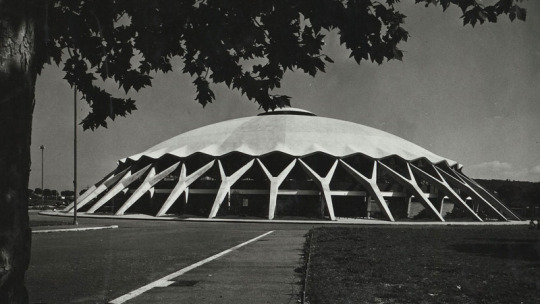
#architecture#design#retro#vintage#35mm#b&w#uk#scotland#East Kilbride#aqua#water#Alexander Buchanan Campbell#parabolic#concrete#brutalism#brutalist#pool#swimming#leisure
116 notes
·
View notes
Text
Brutalist Paraboloid
Stunning Sainte Thérèse church in Metz.
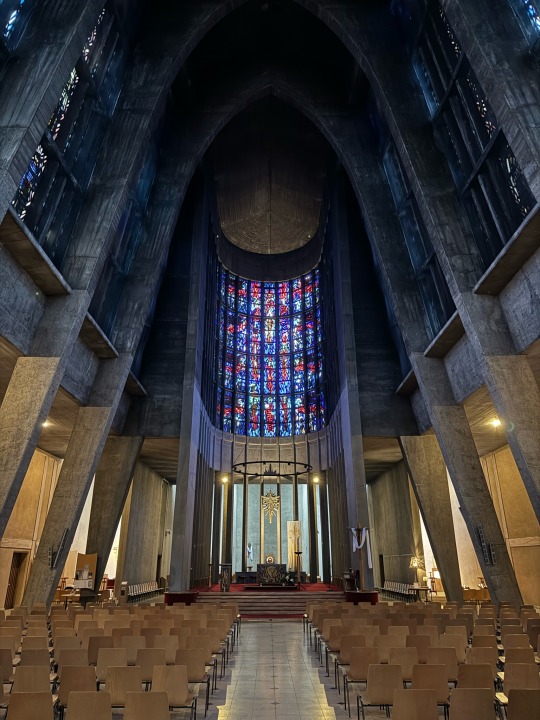
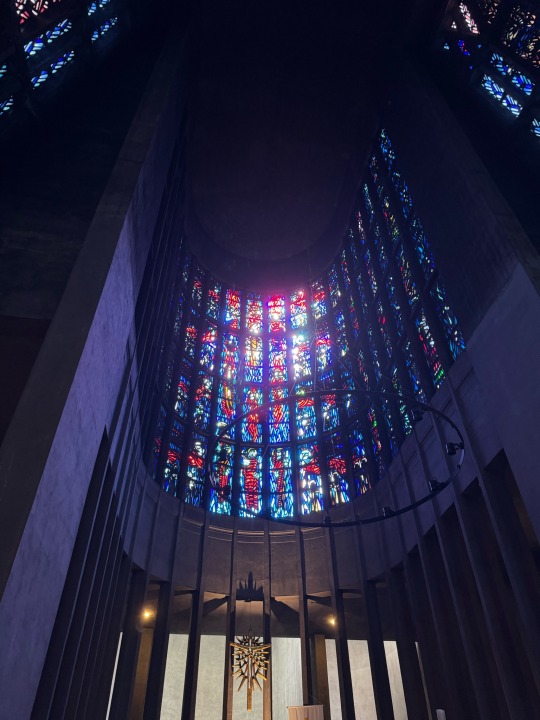
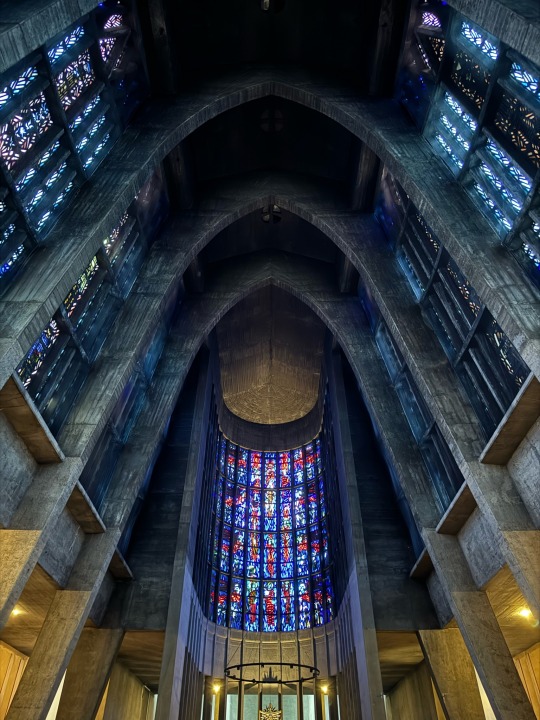

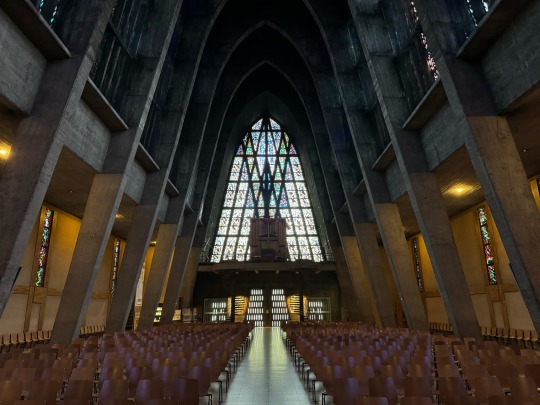

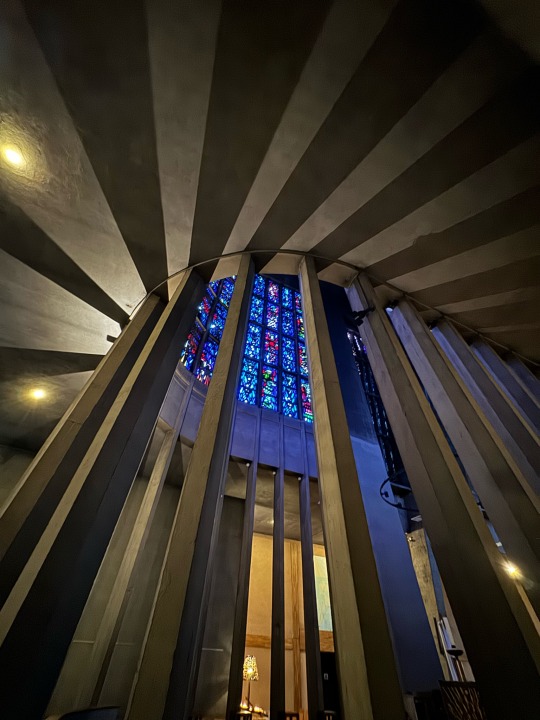
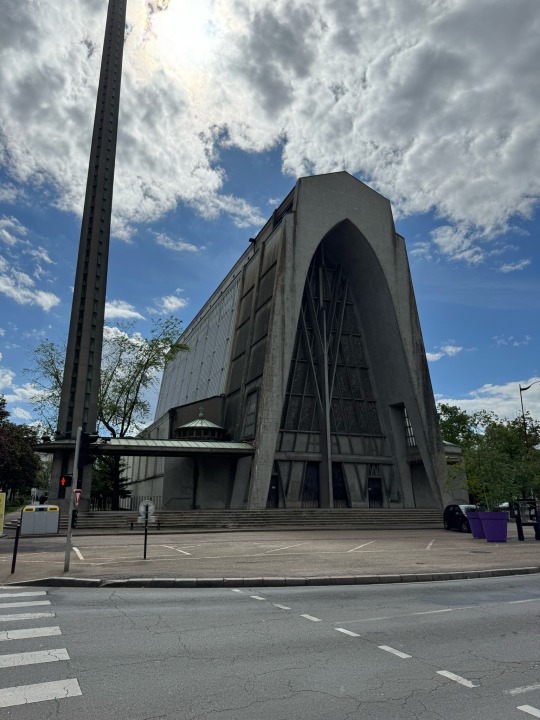
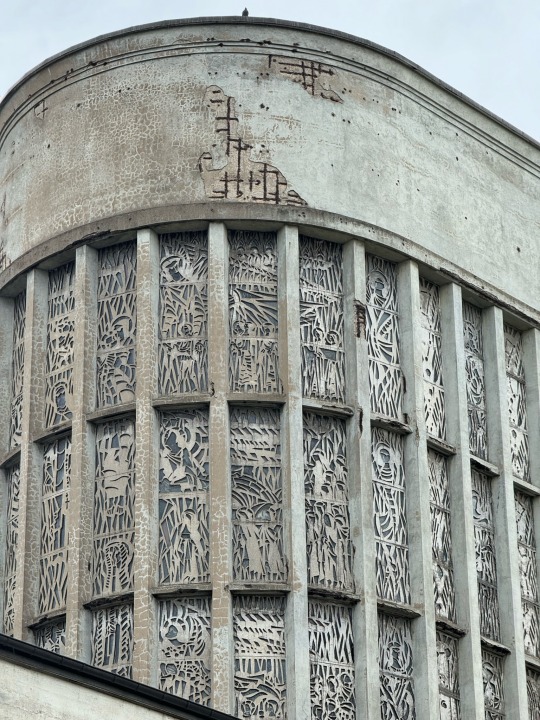

Brutalism at its finest.
#brutalism#architecture#cathedral#france#metz#reinforcedconcrete#stained glass#concreteandglass#monumentalscale#parabolic#sainte therese
503 notes
·
View notes
Text
🐴Walking Stims
Taking stairs: 2-3 at a time. Uses your whole leg, feels fast.
Taking corners: 90 degree turns. Slower than parabolics but feels sudden and resolute. Staying aligned to architecture is best though, if the wall curves, you curve.
Sectioned Surface: Either hit every crack, or none. Disrupts normal stride length, which feels nice until it suddenly doesn't.
Hard Surface: heels raised. Bouncy, pleasant calf use, taller than usual for a unique perspective.
Soft Surface: heel-ball-toe. Shoulders completely flat, just gliding along, uniform visual motion, silent.
4 notes
·
View notes
Photo

Night Sky House in #Blackheath, Australia by Peter Stutchbury Architecture @peterstutchburyarchitecture. Read more: Link in bio! Photography: Brett Boardman Studio Peter Stutchbury Architecture: The most recent recipient of the highest residential award for architecture in Australia - The Robin Boyd Award 2021. (the Australian Institute of Architects did not award the Robin Boyd Award in 2022). To try to summarise this house is virtually impossible. Walking into the space for the first time is difficult to describe. It feels ancient and modern at the same time. The references are so varied, "it feels like a church, a castle, a railway arch, a middle eastern grain store". The commissioning client was inspired by a 19th-century ammunition bunker he once saw in Romania built of raw brick with arches. The architect references work by Le Corbusier in India. However, it is distinctly a singular design. The key architectural feature is the parabolic vaulted ceiling, a self-supporting structure made of recycled bricks having a 3.5m long by 2.5m wide elliptical retractable skylight that is unglazed and tilted 20 degrees to the south to gaze at the stars… #casa #australia #архитектура www.amazingarchitecture.com ✔ A collection of the best contemporary architecture to inspire you. #design #architecture #amazingarchitecture #architect #arquitectura #luxury #realestate #life #cute #architettura #interiordesign #photooftheday #love #travel #construction #furniture #instagood #fashion #beautiful #archilovers #home #house #amazing #picoftheday #architecturephotography #معماری (at Blackheath, New South Wales) https://www.instagram.com/p/CqLNUOXsdZu/?igshid=NGJjMDIxMWI=
#blackheath#casa#australia#архитектура#design#architecture#amazingarchitecture#architect#arquitectura#luxury#realestate#life#cute#architettura#interiordesign#photooftheday#love#travel#construction#furniture#instagood#fashion#beautiful#archilovers#home#house#amazing#picoftheday#architecturephotography#معماری
19 notes
·
View notes
Text
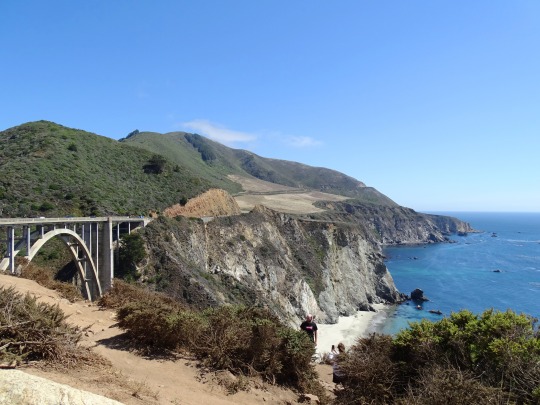


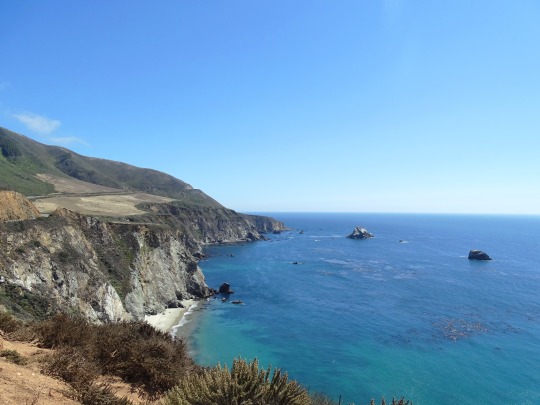


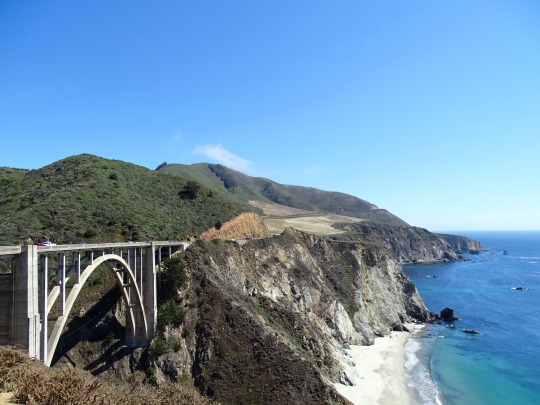



Bixby Bridge, CA (No. 1)
Bixby Bridge, also known as Bixby Creek Bridge, on the Big Sur coast of California, is one of the most photographed bridges in California due to its aesthetic design, "graceful architecture and magnificent setting". It is a reinforced concrete open-spandrel arch bridge. The bridge is 120 miles (190 km) south of San Francisco and 13 miles (21 km) south of Carmel in Monterey County on State Route 1.
Before the opening of the bridge in 1932, residents of the Big Sur area were virtually cut off during winter due to blockages on the often impassable Old Coast Road, which led 11 miles (18 km) inland. The bridge was built under budget for $199,861 (equivalent to $3.64 million in 2023 dollars) and, at 360 feet (110 m), was the longest concrete arch span in the California State Highway System. When it was completed, it was the highest single-span arch bridge in the world, and it remains one of the tallest.
The land north and south of the bridge was privately owned until 1988 and 2001. A logging company obtained approval to harvest redwood on the former Bixby Ranch to the north in 1986, and in 2000 a developer obtained approval to subdivide the former Brazil Ranch to the south. Local residents and conservationists fought their plans, and both pieces of land were eventually acquired by local and federal government agencies. A $20 million seismic retrofit was completed in 1996, although its 24-foot (7.3 m) width does not meet modern standards requiring bridges to be 32 feet (9.8 m) wide.
The bridge is "one of the most photographed features on the West Coast" and in the world. It has been featured on "postcards, TV ads, everywhere," according to Debra Geiler, project manager for the Trust for Public Land. The bridge's location on the scenic Central Coast of California, the parabolic shape of the arch, the tall spandrel columns, and the architectural piers contribute to an "intense aesthetic experience." "It's the gateway to Big Sur and the interior has never been logged. The land is pristine." Zad Leavy, former executive director of the Big Sur Land Trust, described the land as "...the most spectacular meeting of ocean and land in the entire United States."
Source: Wikipedia
#Bixby Creek Bridge#Bixby Bridge Vista Point#Bixby Bridge#Little Sur River Beach#Monterey County#California State Route 1#Highway 1#Pacific Coast Highway#National Scenic Byway#Big Sur#Pacific Ocean#travel#original photography#vacation#tourist attraction#landmark#landscape#seascape#countryside#street scene#road trip#summer 2022#California#West Coast#Big Sur Coast Highway#nature#flora#grass#USA#blue sky
2 notes
·
View notes
Text
Freerunning in Nairo

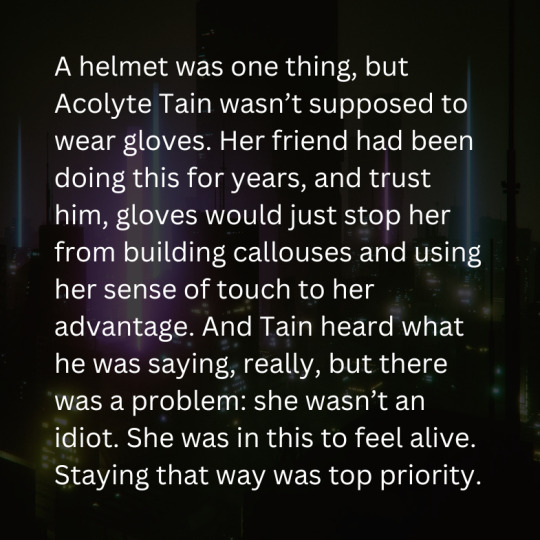


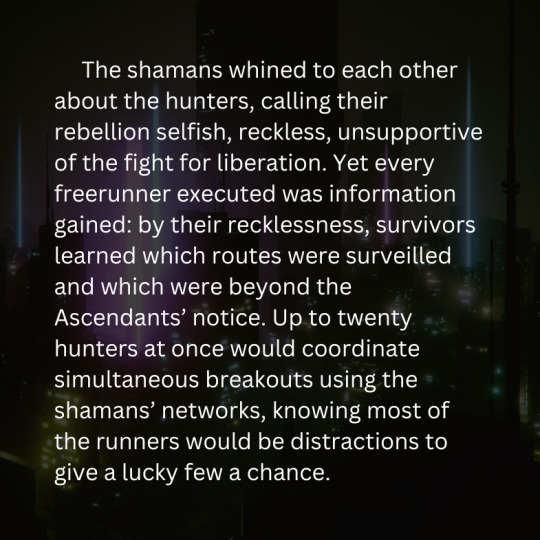
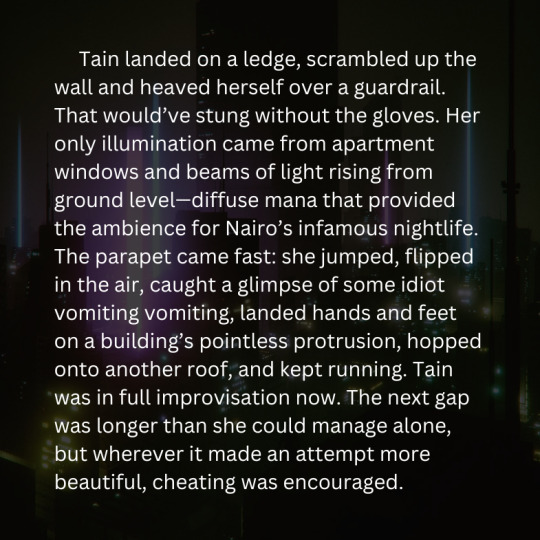
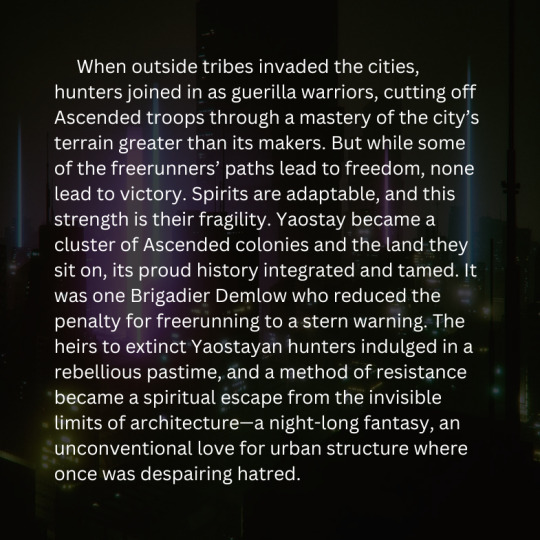

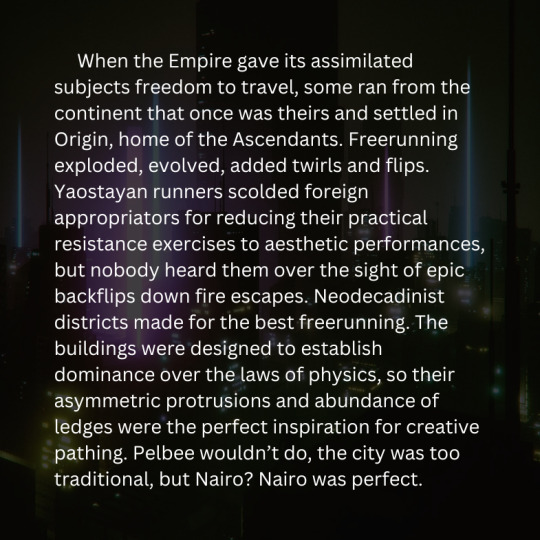

A helmet was one thing, but Acolyte Tain wasn’t supposed to wear gloves. Her friend had been doing this for years, and trust him, gloves would just stop her from building callouses and using her sense of touch to her advantage. And Tain heard what he was saying, really, but there was a problem: she wasn’t an idiot. She was in this to feel alive. Staying that way was top priority.
Freerunning started in conversion cities. When Ascended soldiers trapped Yaostayans in towns optimized for assimilation, some prisoners held onto their sense of identity through small acts of rebellion. While shamans built secret communication networks, hunters escaped their apartments after curfew. They raced across rooftops, pursuing imagined ghosts of the beasts that once lived on these lands. They could cover two blocks, three if they were good, before someone noticed their empty cell. Those who did not return in time did not return at all.
Realistically, Tain wasn’t ready. But she was never going to be ready until she tried. She stretched her arms over her head, glimpsed over the edge to the streets below, tasted the crisp nighttime smog, and ran. With so much practice, clearing the eight-foot gap to the next roof was simple. The acolyte brought a crucial lesson to freerunning from her studies: maintaining momentum was everything. It kept objects in motion, minds quick and souls three steps ahead of fear. Momentum took her over the next gap in turn, ten feet across.
The shamans whined to each other about the hunters, calling their rebellion selfish, reckless, unsupportive of the fight for liberation. Yet every freerunner executed was information gained: by their recklessness, survivors learned which routes were surveilled and which were beyond the Ascendants’ notice. Up to twenty hunters at once would coordinate simultaneous breakouts using the shamans’ networks, knowing most of the runners would be distractions to give a lucky few a chance.
Tain landed on a ledge, scrambled up the wall and heaved herself over a guardrail. That would’ve stung without the gloves. Her only illumination came from apartment windows and beams of light rising from ground level—diffuse mana that provided the ambience for Nairo’s infamous nightlife. The parapet came fast: she jumped, flipped in the air, caught a glimpse of some idiot vomiting vomiting, landed hands and feet on a building’s pointless protrusion, hopped onto another roof, and kept running. Tain was in full improvisation now. The next gap was longer than she could manage alone, but wherever it made an attempt more beautiful, cheating was encouraged.
When outside tribes invaded the cities, hunters joined in as guerilla warriors, cutting off Ascended troops through a mastery of the city’s terrain greater than its makers. But while some of the freerunners’ paths lead to freedom, none lead to victory. Spirits are adaptable, and this strength is their fragility. Yaostay became a cluster of Ascended colonies and the land they sit on, its proud history integrated and tamed. It was one Brigadier Demlow who reduced the penalty for freerunning to a stern warning. The heirs to extinct Yaostayan hunters indulged in a rebellious pastime, and a method of resistance became a spiritual escape from the invisible limits of architecture—a night-long fantasy, an unconventional love for urban structure where once was despairing hatred.
All at once the engineer conjured orbs of mana in her hands, tightened her core, fantasized about parabolic arcs, stomped the ledge, threw the spheres at her shoe, and sprung. With strength she didn’t possess, Tain’s foot threw her sideways at an adjacent highrise. Her hands and feet hit the bricks, and before gravity could object, her limbs shone with mystic power and threw her toward the sky with a backward flip, spinning trails of fierce pink and blue following in her wake. She gasped, pointed her open grin upward, and threw her arms wide to embrace the freedom she always owned but never felt. School was gone up here. Her parents, the world and all its problems, nothing in the sky was real but her body, the oxygen and pillars of light. Then she looked down and processed how much higher she’d flown than she planned. Shitshitshit. Tain had a spell to slow her fall, it was basic preparation, but as she plummeted toward the rooftop adrenaline killed her focus.
When the Empire gave its assimilated subjects freedom to travel, some ran from the continent that once was theirs and settled in Origin, home of the Ascendants. Freerunning exploded, evolved, added twirls and flips. Yaostayan runners scolded foreign appropriators for reducing their practical resistance exercises to aesthetic performances, but nobody heard them over the sight of epic backflips down fire escapes. Neodecadinist districts made for the best freerunning. The buildings were designed to establish dominance over the laws of physics, so their asymmetric protrusions and abundance of ledges were the perfect inspiration for creative pathing. Pelbee wouldn’t do, the city was too traditional, but Nairo? Nairo was perfect.
Only practice could save Tain now: she leaned forward, her hands touched the concrete, elbows bent, but the signal from her hands reached her brain just too slow. Tain landed on her side. A bullet ran up her leg. She yelped, clutched her thigh and restrained tears. She breathed hard, breathed until her inner wind could extinguish the burning. Okay. It couldn’t be broken. She pushed herself to her feet. Her knees shook and her head pounded, but she was stable. The acolyte tore off her helmet, sighed with relief, leaned against the parapet and giggled. This was life, wasn’t it? When she glanced at the next building, one taller than her new vantage, she shooed it away and took the fire exit. Through the streets of Nairo, streets that were so small just minutes ago, she stumbled homeward. Tain tucked her helmet beneath her arm, and as she passed a narrow alley, she unstrapped her gloves and tossed them in a puddle of vomit.
---
Yaldev is a sci-fantasy worldbuilding project by Ulysses Maurer, with art by Beeple. By looking at narratives, stylized loredumps, bad poetry and little details, we'll witness the story of a planet filled with magical power, the nation which tried to conquer it, this empire’s dramatic collapse and the new world which emerged in its wake. Along the way we'll meet the characters who live here, and we'll explore questions about nationalism, rationalism, the natural world and the quest to master it. For all stories in chronological order, check out the pinned posts at r/Yaldev!
#beeple#fantasy#scifi#worldbuilding#writing#everyday#short story#surreal#dystopia#dystopian#dystopian fiction#science fiction#science fantasy#sci fantasy#sci-fantasy#scifantasy#sf#sff#worldbuild#worldbuilder#worldbuilders#magic#d&d#dnd#canadian writers#escapism#lore#amwriting
2 notes
·
View notes
Text
Can Lights: The Ultimate Lighting Solution or Just a Trend?
In the world of interior design and lighting, par can lights have surged in popularity, becoming a go-to choice for both residential and commercial spaces. Known for their sleek appearance and versatility, these recessed fixtures offer a modern aesthetic that appeals to many. However, some may wonder: are can lights the ultimate lighting solution, or are they simply a passing trend? This article delves into the benefits of can lights, factors to consider when choosing them, and their potential advantages for businesses.

What Are Par Can Lights?
Par can lights, or parabolic reflector can lights, are recessed lighting fixtures that utilize specialized bulbs designed to produce focused beams of light. Often used in theaters and concert venues, they are increasingly being integrated into homes and offices for their stylish, unobtrusive design. Their ability to blend seamlessly into ceilings allows for a clean look while providing effective illumination.
Are Can Lights a Trend or a Timeless Solution?
1. Design Flexibility
Do can lights offer versatility in design?
Yes! One of the most significant advantages of can lights is their design flexibility. They can suit a variety of architectural styles, from modern to traditional. Their recessed nature allows for multiple installations, including in living rooms, kitchens, bathrooms, and even commercial spaces. Unlike pendant lights or chandeliers, which can dominate a room, can lights provide a minimalist look that doesn't overwhelm the decor.
2. Energy Efficiency
How do can lights compare in terms of energy efficiency?
When equipped with LED bulbs, can lights are highly energy-efficient, consuming far less electricity than traditional incandescent or halogen fixtures. This energy efficiency not only reduces electricity bills but also contributes to a lower carbon footprint. As sustainability becomes increasingly important in design choices, can lights position themselves as a responsible lighting option.
3. Focused Lighting
Can can lights provide targeted illumination?
Absolutely! Par can lights are designed to create focused beams of light, making them ideal for accentuating specific areas or features in a room. Whether you want to highlight artwork, illuminate a kitchen island, or create a cozy reading nook, can lights excel in providing targeted lighting. This capability enhances the overall aesthetic of a space while also improving functionality.
4. Low Maintenance Requirements
Are can lights easy to maintain?
Yes, they are! One of the appealing aspects of can lights is their low maintenance needs. LED bulbs have long lifespans, meaning fewer replacements. Additionally, because they are recessed, they tend to gather less dust and grime compared to surface-mounted fixtures, making cleaning easier. This is especially beneficial in commercial environments, where upkeep can be a significant concern.
Factors to Consider When Choosing Can Lights
1. Ceiling Height
Do ceiling height considerations impact can light effectiveness?
Yes, ceiling height is a critical factor. Can lights generally perform best in spaces with higher ceilings, where their focused beams can shine without overwhelming the room. For lower ceilings, opt for shallow can lights or low-profile designs to prevent a cramped feeling. Proper placement is crucial for maximizing their effectiveness.
2. Purpose of the Space
What role does the function of a room play in selecting can lights?
Understanding the primary function of a room can greatly influence your choice of lighting. Can lights are ideal for kitchens, workspaces, and living areas that require focused task lighting. In contrast, areas designed for relaxation, such as bedrooms, might benefit from softer, more diffused lighting. Combining can lights with other light sources can help achieve the desired ambiance.
3. Placement and Spacing
How should can lights be positioned for optimal performance?
Proper placement and spacing of can lights are essential for even illumination. A general guideline is to space fixtures about 4 to 6 feet apart for adequate light coverage. When positioning can lights, consider directing them toward walls or artwork to create depth and visual interest in the room.
4. Installation Complexity
Is installing can lights a challenging task?
While installing can lights may require more effort than hanging traditional fixtures, it is not necessarily difficult. Many homeowners can undertake this as a DIY project if they have basic electrical knowledge. However, hiring a professional is advisable, especially when dealing with electrical work. Professionals ensure that fixtures are installed safely and correctly, optimizing their performance.
How Can Businesses Benefit from Can Lights?
For businesses, the benefits of can lights extend far beyond aesthetics:
Enhanced Ambiance: Good lighting significantly impacts the atmosphere of a commercial space. Can lights allow businesses to create a welcoming environment that encourages customer engagement. The ability to adjust brightness through dimmers further enhances flexibility in creating various moods.
Cost Efficiency: With rising energy costs, businesses are constantly looking for ways to cut expenses. The energy efficiency of can lights translates into lower utility bills, freeing up funds for other essential areas. Over time, the savings can be substantial, making can lights a wise financial investment.
Showcasing Products: In retail environments, can lights can effectively highlight merchandise and displays. Their focused illumination draws attention to featured products, enhancing visibility and potentially increasing sales. The right lighting can make a significant difference in customer purchasing decisions.
Adaptability for Events: Many businesses host events or meetings, requiring flexibility in lighting. Can lights can be adjusted to suit various needs, from formal presentations to casual gatherings. This adaptability makes them ideal for multipurpose spaces, ensuring that lighting aligns with the occasion.
In conclusion, can lights, particularly par can lights, are far more than just a fleeting trend. Their combination of energy efficiency, design flexibility, low maintenance, and focused lighting capabilities makes them a valuable choice for both residential and commercial applications. By considering factors such as ceiling height, room purpose, and placement, homeowners and business owners alike can harness the full potential of can lights in their spaces.
For businesses, the benefits are multifaceted—enhancing ambiance, reducing operational costs, and improving product visibility. As more people prioritize both aesthetics and functionality in their lighting choices, can lights are poised to remain a relevant and essential option in the world of interior design. Whether you're looking to elevate your home or enhance a business environment, can lights may just be the ultimate lighting solution you've been seeking.
0 notes
Text
youtube
This is a previously undiscovered African house, from east Kenya,. It is almost on the edge of extinction, with the tradition being preserved by one remarkable young woman, Ramadan. The tiny home, a beautiful example of organic architecture, is constructed by around twenty women builders over three days, usually just before a marriage. The house is unusually high, with a raised up bed, and this is to protect the occupants from the occasional flooding of the river Tana. All the natural materials are gathered from within a few kilometers of the village. Essentially it is a bentwood frame lashed together into a gridshell. The whole structure is strong as it is a natural parabolic dome. The area is undergoing rapid change as modern materials and electricity are being brought in, so we were very fortunate to be able to record this building before it disappears completely.
0 notes
Text
"I didn't know wind could do that"
"We didn't take enough soil samples"
"That's more water than we expected"
"They didn't warn us about parabolic mirrors in architecture school"
"That's going to become a new safety regulation"
CAUSES OF ENGINEERING DISASTERS:
"huh, didn't know that material behaved that way"
"well luckily *this* load case will never happen"
"I TOLD YOU. I TOLD YOU ALL. BUT YOU SAID THE FIX WAS TOO EXPENSIVE AND WOULD TAKE TOO LONG"
"you were using it to do *what*???"
"shouldn't we get this change approved by a regulatory body?" "nah"
"wait we were meant to inspect that part of the structure?"
4K notes
·
View notes
Text
LED Par Lights Wholesaler

ATI Pro Technologies brand is more precisely into research and development of pro audio & lighting products. As a premier supplier, wholesaler, and importer of LED Par Lights are versatile lighting fixtures equipped with multiple light-emitting diodes (LEDs) arranged in a parabolic shape. They offer a wide spectrum of colors, adjustable brightness, and various beam angles, making them ideal for stage lighting, architectural illumination, and event decoration. Energy-efficient and durable, they provide vibrant and dynamic lighting solutions for diverse applications.
0 notes
Text

On Wednesday, SpaceX launched two prototype satellites for the Missile Defense Agency and four missile-tracking satellites for the US Space Force from Florida's Space Coast using a Falcon 9 rocket. These satellites are built to track hypersonic missiles from countries like China, Russia, Iran, and North Korea. They're part of a new generation of spacecraft aimed at enhancing defense against emerging missile threats. Hypersonic missiles are smaller and more maneuverable than conventional ballistic missiles, which the US military's legacy missile defense satellites can detect when they launch. Infrared sensors on the military's older-generation missile tracking satellites are tuned to pick out bright thermal signatures from missile exhaust. The New Threat Paradigm Hypersonic missiles represent a new challenge for the Space Force and the Missile Defense Agency (MDA). For one thing, ballistic missiles follow a predictable parabolic trajectory that takes them into space. Hypersonic missiles are smaller and comparatively dim, and they spend more time flying in Earth's atmosphere. Their maneuverability makes them difficult to track. A nearly five-year-old military organization called the Space Development Agency (SDA) has launched 27 prototype satellites over the last year to prove the Pentagon's concept for a constellation of hundreds of small, relatively low-cost spacecraft in low-Earth orbit. This new fleet of satellites, which the SDA calls the Proliferated Warfighter Space Architecture, will eventually number hundreds of spacecraft to track missiles and relay data about their flight paths down to the ground. The tracking data will provide an early warning to those targeted by hypersonic missiles and help generate a firing solution for interceptors to shoot them down. The SDA constellation combines conventional tactical radio links, laser inter-satellite communications, and wide-view infrared sensors. The agency, now part of the Space Force, plans to launch successive generations, or tranches, of small satellites, each introducing new technology. The SDA's approach relies on commercially available spacecraft and sensor technology and will be more resilient to attack from an adversary than the military's conventional space assets. Those legacy military satellites often cost hundreds of millions or billions of dollars apiece, with architectures that rely on small numbers of large satellites that might appear like a sitting duck to an adversary determined to inflict damage. Four of the small SDA satellites and two larger spacecraft for the Missile Defense Agency were aboard a SpaceX Falcon 9 rocket when it lifted off from Cape Canaveral Space Force Station at 5:30 pm EST (2230 UTC) Wednesday. The rocket headed northeast from Cape Canaveral to place the six payloads into low-Earth orbit. Officials from the Space Force declared the launch a success later Wednesday evening. The SDA's four tracking satellites, built by L3Harris, are the last spacecraft the agency will launch in its prototype constellation, called Tranche 0. Beginning later this year, the SDA plans to kick off a rapid-fire launch campaign with SpaceX and United Launch Alliance to quickly build out its operational Tranche 1 constellation, with launches set to occur at one-month intervals to deploy approximately 150 satellites. Then, there will be a Tranche 2 constellation with more advanced sensor technologies. The primary payloads aboard Wednesday's launch were for the Missile Defense Agency. These two Hypersonic and Ballistic Tracking Space Sensor (HBTSS) satellites, one supplied by L3Harris and the other by Northrop Grumman, will demonstrate medium field-of-view sensors. Those sensors can't cover as much territory as the SDA satellites but will provide more sensitive and detailed missile tracking data.
#Branding#Business#Investment#Science#arstechnica#Designed#elonmusk#Hypersonic#Launched#Military#missiles#satellites#spacex#Track
1 note
·
View note
Text
Solar Panel Market May See a Big Move 2024-2030
Solar Panel Market May See a Big Move 2024-2030
Global Solar Panel Market, Solar Panel Market Demand, Solar Panel Market Trends, Solar Panel Market Analysis, Solar Panel Market Growth, Solar Panel Market Share, Solar Panel Market Forecast, Solar Panel Market Challenges, Solar Panel Market Opportunity
At Intellect Markets, published a new research publication on "Solar Panel Market Insights, to 2030" with 232 pages and enriched with self-explained Tables and charts in presentable format. In the Study you will find new evolving Trends, Drivers, Restraints, Opportunities generated by targeting Market associated stakeholders. The growth of the Solar Panel Market was mainly driven by the increasing R&D spending across the world.
Get Free Exclusive PDF Sample Copy of This Research @ https://intellectmarkets.com/report/solar-panel-market
Some of the key players profiled in the study are: Abengoa Solar S.A., Acciona Energia S.A., Wuxi Suntech Power Co. Ltd., Bright Source Energy Inc., Esolar Inc., Gintech Energy Corp., Kaneka Corp., Sunpower Corporation, Canadian Solar Inc., and Tata Power Solar.
Scope of the Report of Solar Panel Market: The Scope of the Solar Energy Market is driven by an increase in environmental pollution and the provision of state incentives & tax rebates to put in solar panels. Additionally, a decrease in water footprint related to solar power systems has fuelled with their demand in power generation sectors. The demand for solar Panels has obtain more grip due to a surge in rooftop installations, followed by an increase in applications within the architectural sector. As technology advances and becomes more affordable, more individuals and businesses are opting to install solar panels on their rooftops to generate clean energy and reduce electricity bills. Furthermore, the demand for parabolic troughs and solar energy towers in electricity generation is predicted to spice up the demand for concentrated solar energy systems. The Global Solar Energy Market report provides a holistic evaluation of various aspects of the market, including key segments, trends, drivers, restraints, competitive landscape, and other factors influencing the market. This comprehensive analysis helps stakeholders make informed decisions and understand the dynamics of the solar energy market.
Market Trends: The Global Solar Energy Market report provides a holistic evaluation of various aspects of the market, including key segments, trends, drivers, restraints, competitive landscape, and other factors influencing the market. This comprehensive analysis helps stakeholders make informed decisions and understand the dynamics of the solar energy market.
Opportunities: The solar panel market presents various opportunities driven by factors such as technological advancements, increasing energy demand, government support, and a growing focus on sustainability. Ongoing research and development in solar panel technologies create opportunities for more efficient and cost-effective solutions. The integration of solar panels with energy storage systems, such as batteries, presents a significant opportunity. Hybrid systems can offer a more consistent and reliable power supply, addressing the intermittency challenge associated with solar energy.
Market Drivers: Residential, Commercial, Growing Need for Solar Panel Market. Industrial Growth of the Solar Panel Market
Have Any Questions Regarding Global Solar Panel Market Report, Ask Our Experts@ https://intellectmarkets.com/report/solar-panel-market/ask-an-expert
The Titled Segments and Sub-Section of The Market Are Illuminated Below: Global Solar Panel Market Size By Solar Module (Monocrystalline, Polycrystalline, Cadmium Telluride), By Application (Residential, Commercial, Industrial), By End User (Electricity Generation, Lighting, Heating, Charging),
Read Detailed Index of Full Research Study at @ https://intellectmarkets.com/report/solar-panel-market/ask-an-expert
Thanks for reading this article; you can also get region wise report version like Global, North America, Middle East, Africa, Europe, South America, etc
Contact US: Intellect Markets, Unit No. 4, Lakshmi Enclave, Nizam pet, Hyderabad, Telangana, India - 500090 Phone: +1 347 514 7411, +91 8688234923 [email protected]
0 notes
Text

Albion Museum Collection – The Wallace
On display in the Wallace Collection in London is a sword that for some reason has largely been overlooked by modern enthusiasts (A458). Perhaps it is because it is a bit ravaged by rust and therefore have lost some of its original crispness and integrity of form. Perhaps it is because of its unusual proportions and uniquely shaped hilt. However, because of its unique character it stands out as one of the most beautiful type Xa swords that survive to our time.
The sword has a wide blade and a fuller running almost its whole length. The guard is slim with a slight and graceful curve towards the blade. The pommel is wide and surprisingly slim. It was made to be a light weapon for swift maneuvers and biting cuts. Its proportions suggest its maker was concerned not only with the tactics of the battlefield but also with the deeper meaning of knightly duties and virtues. The Albion Museum Line version of this iconic weapon is based on hands-on documentation of the original. Its outline and original shape have been carefully reconstructed following precise tracings and measurements.
The blade is a classic example of the XIa type: a moderate length and a bit wider than type XI blades, with a distinctive, narrow fuller. The two edges follow a parabolic tapering curve toward the point rather than a straight taper. The cross section is a lean lenticular shape. The guard is a style 11 with ends that expand slightly into a droplet shape. The pommel is a thin version of type G with a lentcular section.
On their own, each part of the sword seems simple and uncomplicated but taken together the effect is a sword with a serene and subtle beauty. Its light weight combined with a point of balance that is quite far from the guard makes it a quick and extremely responsive sword that will deliver biting cuts with great precision and timing.
An analysis of its proportions suggest that it was designed according to geometric principles. When artisans, architects, engineers and artists of this period wanted to create works imbued with sacred concepts, geometric design provided the underlying structure of proportions between the parts and the whole. Architecture, sculpture, painting, the art of the book and even music was created according to principles of harmony similarly based on arithmetic and geometry. The geometry of A458 suggests that it was made for a sacred purpose. Perhaps it was the sword of a crusader. Perhaps its owner thought of it as a blessed or even magical sword.
#Kult of Athena#KultOfAthena#New Item Wednesday#Albion#Museum Collection#The Wallace#Wallace Collection#London#Type XIa#sword#swords#weapon#weapons#blade#blades#European Swords#European Weapons#Medieval Swords#Medieval Weapons#Longswords#Battle Ready#6150 High Carbon Steel
0 notes